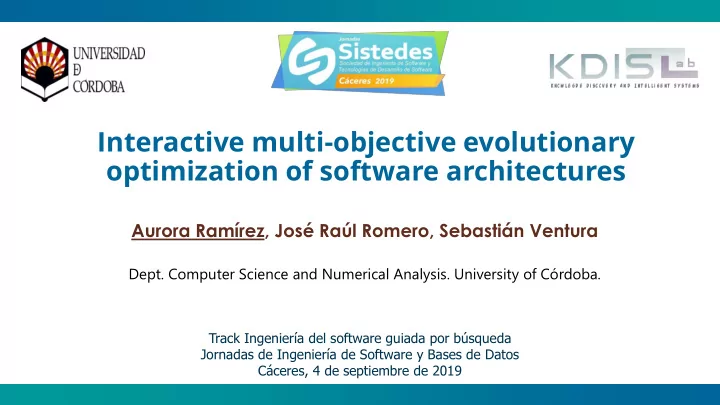

Interactive multi-objective evolutionary optimization of software architectures Aurora Ramírez, José Raúl Romero, Sebastián Ventura Dept. Computer Science and Numerical Analysis. University of Córdoba. Track Ingeniería del software guiada por búsqueda Jornadas de Ingeniería de Software y Bases de Datos Cáceres, 4 de septiembre de 2019
Content 1. Introduction 2. Background 3. Interactive algorithm 4. Empirical study 5. Conclusions A. Ramírez, J.R. Romero, S. Ventura. “Interactive multi - objective evolutionary optimization of software architectures”. Information Sciences , vol. 463-464, pp. 92-109. 2018. Interactive multi-objective evolutionary optimization of software architectures. ISGB@JISBD'19. [2/13]
Introduction ▪ Software design is a human-centered task ▪ Qualitative aspects are difficult to quantify ▪ The engineer should be involved in the optimization process ▪ Sometimes it is easier to identify a bad solution rather than a good one Interactive multi-objective evolutionary optimization of software architectures. ISGB@JISBD'19. [3/13]
Introduction RQ1: How can the qualitative judgement of the engineer be integrated into the evolutionary discovery of software architectures? RQ2: Does putting the human in the loop involve a significant improvement compared with not considering him/her along the optimization process? Interactive multi-objective evolutionary optimization of software architectures. ISGB@JISBD'19. [4/13]
Background Architecture discovery To identify the underlying component-based architecture of the system from the analysis information contained in a UML class diagram Component: a cohesive group of classes that work together to satisfy the expected behavior of the component Interface: a directed relationship between classes belonging to different components Connector: The linkage between required/provided interfaces Interactive multi-objective evolutionary optimization of software architectures. ISGB@JISBD'19. [5/13]
Background Interactive optimization Full automation is not always realistic: Any optimization method, including metaheuristics, in which the human • Uncertainty scenarios actively participates in any step of • Creative tasks the process to provide feedback Human is “put in the loop” : • To provide problem knowledge • To increase trust on automatic results • To meet user’s expectations Design and implementation decisions: • Selection of solutions • Type of feedback • Frequency of interaction • Information lifetime Interactive multi-objective evolutionary optimization of software architectures. ISGB@JISBD'19. [6/13]
Interactive algorithm Overview ▪ Steady-state algorithm: two offspring are produced in each generation ▪ Archive to store a small set of representative solutions ▪ Binary tournament selection from population and archive ▪ Offspring replace population members with worst fitness Interactive multi-objective evolutionary optimization of software architectures. ISGB@JISBD'19. [7/13]
Interactive algorithm Fitness function A novel fitness function that combines objective and subjective evaluation criteria 𝑔𝑗𝑢𝑜𝑓𝑡𝑡 𝑡 = 𝑥 𝑝𝑐𝑘 ∙ 𝑔 𝑝𝑐𝑘 𝑡 + 𝑥 𝑡𝑣𝑐 ∙ 𝑔 𝑡𝑣𝑐 𝑡 Quantitative : Maximin function to quantify both dominance and diversity (software measures) 𝑡 − 𝑔 𝑨 ) 𝑝𝑐𝑘 𝑡 = 1 + 𝑛𝑏𝑦 𝑨≠𝑡 (𝑛𝑗𝑜 𝑙 𝑔 𝑙 𝑙 𝑔 ∀𝑨 ∈ 𝑎 2 Qualitative : Engineer’s preferences on phenotypic aspects of the solution (architectural preferences) 𝑡𝑣𝑐 𝑡 = 1 − 1 𝑄 𝑄 ∙ σ 𝑞=1 𝑔 𝑥 𝑞 ∙ 𝑞𝑠𝑓𝑔 𝑞 𝑡 Interactive multi-objective evolutionary optimization of software architectures. ISGB@JISBD'19. [8/13]
Interactive algorithm Architectural preferences Preference Description Best component Similarity to the set of classes Worst component Dissimilarity to the set of classes Best provided interface Similarity to the set of operations Worst provided interface Dissimiliraty to the set of operations Number of components Distance to the preferred number Metric in range Distance to the midrange Aspiration levels Weighted distance to the reference point 𝑐𝑑 𝑡 = 𝑛𝑏𝑦 𝐾(𝑑𝑚𝑏𝑡𝑡𝑓𝑡 𝑑 , 𝑑𝑚𝑏𝑡𝑡𝑓𝑡 𝑑 ∗ ) 𝑞𝑠𝑓𝑔 ∀𝑑 ∈ 1, 𝑜 𝐾(𝐵, 𝐶) = 𝐵 ∩ 𝐶 𝐵 ∪ 𝐶 Interactive multi-objective evolutionary optimization of software architectures. ISGB@JISBD'19. [9/13]
Interactive algorithm Interaction mechanism ▪ Interactions are scheduled at regular intervals ▪ Solutions are selected from the current population using a clustering method ▪ The engineer rewards or penalizes some aspect of the solution by choosing one preference ▪ Additional actions: ➢ Freeze one component ➢ Add to the archive ➢ Remove from the population ➢ Stop the search Interactive multi-objective evolutionary optimization of software architectures. ISGB@JISBD'19. [10/13]
Empirical study Methodology: • Case study, 9 participants • 3 interactions, 3 solutions each • Log files and questionnaires Impact of interaction: • Cohesion is indirectly improved • Different number of components • Components are similar or equal to the manual design • Actions (add, freeze) contribute to find better solutions Interactive multi-objective evolutionary optimization of software architectures. ISGB@JISBD'19. [11/13]
Empirical study Analysis of architectural preferences: • More interest in the internal structure • Negative preferences are move frequently applied at the beginning • Use of “no preference” Architectural Selected Useful Intuitive preference (%) [1-8] [1-8] No preference 22.22 6.44 7.33 Best component 29,63 7.44 7.44 Worst component 23.46 7.22 7.33 Best prov. Interface 2.47 5.29 6.38 Worst prov. Interface 0.00 4.71 6.38 No. Components 17.28 7.50 7.33 Metric in range 2.47 4.17 5.44 Aspiration levels 2.47 5.80 5.22 Interactive multi-objective evolutionary optimization of software architectures. ISGB@JISBD'19. [12/13]
Conclusions ✓ Architectural preferences as a novel mechanism for subjective evaluation ✓ Design measures are still needed at the beginning ✓ Negative options are useful too ✓ Humans are willing to participate (even more) in the optimization Future work: ➢ Improve the interactive experience (more preferences and flexibility) ➢ Analyze how other human design abilities could be integrated Interactive multi-objective evolutionary optimization of software architectures. ISGB@JISBD'19. [13/13]
Interactive multi-objective evolutionary optimization of software architectures Aurora Ramírez, José Raúl Romero, Sebastián Ventura Aurora Ramírez aramirez@uco.es https://www.uco.es/users/aramirez @aurora_rq Track Ingeniería del software guiada por búsqueda Jornadas de Ingeniería de Software y Bases de Datos Cáceres, 4 de septiembre de 2019
Interactive algorithm Problem representation and constraints Genotype Architectural solutions (individuals) are coded as multi-layered trees Initialization and constraints Phenotype 1. Random distribution of classes ✓ No empty components and no replicated classes 2. Set interfaces and connectors Isolated or mutually dependant components
Interactive algorithm Architectural preferences 5) Number of components 1) Best component 2) Worst component 6) Metric in range 3) Best provided interface 7) Aspiration levels 4) Worst provided interface
Recommend
More recommend